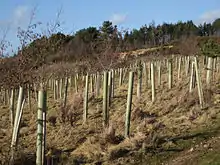Tree shelter
A tree shelter, or tree guard, is a type of plastic shelter used to nurture trees in the early stages of their growth. Tree shelters are also sometimes known as Tuley tubes or tree tubes.

The purpose of tree shelters is to protect young trees from browsing by herbivores by forming a physical barrier along with providing a barrier to chemical spray applications. Additionally, tree tubes accelerate growth by providing a mini-greenhouse environment that reduces moisture stress, channels growth into the main stem and roots and allows efficient control of weeds that can rob young seedlings of soil moisture and sunlight.
Tree shelters were invented in Scotland in 1979 by Graham Tuley (Lantagne 1997). They are particularly popular in the UK in landscape-scale planting schemes and their use has been established in the United States since 2000. About 1 million shelters were in use in the United Kingdom in 1983–1984 (Tuley 1985), and 10 million were produced in 1991 (Potter 1991).
Many variations of tree shelters exist. There is considerable debate among tree shelter manufacturers as to the ideal colour, size, shape and texture for optimal plant growth. One style used in northern climates of North America has a height of 5 feet to offer the best protection from deer browse, with vent holes in the upper portion of the tube to allow for hardening off of hardwood trees going into the winter months and no vent holes in the lower portion to shield seedlings from herbicide spray and rodent damage.
Studies have shown the positive effects of Tree shelters. Not only do they prevent browse from herbivores. They create a mini greenhouse effect that provides stronger growth. Tree Shelters can provide 100% - 200% additional growth vs unprotected trees.
Economics
Tree shelters must be assessed alongside alternatives such as fencing to keep animals out, loss if no shelter is employed and visual impacts.
References
- Lantagne, D. O. (1997). "Using Tree Shelters To Establish Northern Red Oak And Other Hardwoods" (PDF). Michigan State University Extension Bulletin: 2. Retrieved 5 April 2015.
- Potter, M. J. (1991) Treeshelters - Forestry Commission Handbook 7 HMSO
- Tuley, G. (1985). "The growth of young oak trees in shelters". Forestry. 58 (2): 181–19. doi:10.1093/forestry/58.2.181.
- "Independent Studies". Tree.Tube. Retrieved 2019-11-25.
External links
| Wikimedia Commons has media related to Tree shelters. |
